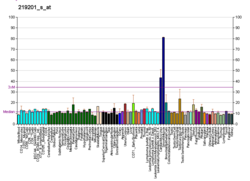Twisted gastrulation protein homolog 1 is a protein that in humans is encoded by the TWSG1 gene.[5][6] The protein is a binding protein for bone morphogenetic proteins, similar to Chordin.[7] The Twisted gastrulation gene is expressed in the extraembryonic tissues during organogenesis, and in certain adult tissues such as the lymph nodes, kidneys, liver, and lungs.[8]
References edit
- ^ a b c GRCh38: Ensembl release 89: ENSG00000128791 – Ensembl, May 2017
- ^ a b c GRCm38: Ensembl release 89: ENSMUSG00000024098 – Ensembl, May 2017
- ^ "Human PubMed Reference:". National Center for Biotechnology Information, U.S. National Library of Medicine.
- ^ "Mouse PubMed Reference:". National Center for Biotechnology Information, U.S. National Library of Medicine.
- ^ Scott IC, Blitz IL, Pappano WN, Maas SA, Cho KW, Greenspan DS (Mar 2001). "Homologues of Twisted gastrulation are extracellular cofactors in antagonism of BMP signalling". Nature. 410 (6827): 475–8. doi:10.1038/35068572. PMID 11260715. S2CID 4392365.
- ^ "Entrez Gene: TWSG1 twisted gastrulation homolog 1 (Drosophila)".
- ^ Oelgeschläger M, Larraín J, Geissert D, De Robertis EM (2000). "The evolutionarily conserved BMP-binding protein Twisted gastrulation promotes BMP signalling". Nature. 405 (6788): 757–63. Bibcode:2000Natur.405..757O. doi:10.1038/35015500. PMC 2292104. PMID 10866189.
- ^ Graf D, Timmons PM, Hitchins M, Episkopou V, Moore G, Ito T, Fujiyama A, Fisher AG, Merkenschlager M (July 2001). "Evolutionary conservation, developmental expression, and genomic mapping of mammalian Twisted gastrulation". Mammalian Genome. 12 (7): 554–560. doi:10.1007/s0033501-0005-x. ISSN 0938-8990. PMID 11420619. S2CID 36371559. Retrieved 6 March 2023.
Further reading edit
- Graf D, Nethisinghe S, Palmer DB, et al. (2002). "The developmentally regulated expression of Twisted gastrulation reveals a role for bone morphogenetic proteins in the control of T cell development". J. Exp. Med. 196 (2): 163–71. doi:10.1084/jem.20020276. PMC 2193926. PMID 12119341.
- Strausberg RL, Feingold EA, Grouse LH, et al. (2003). "Generation and initial analysis of more than 15,000 full-length human and mouse cDNA sequences". Proc. Natl. Acad. Sci. U.S.A. 99 (26): 16899–903. Bibcode:2002PNAS...9916899M. doi:10.1073/pnas.242603899. PMC 139241. PMID 12477932.
- Zakin L, De Robertis EM (2004). "Inactivation of mouse Twisted gastrulation reveals its role in promoting Bmp4 activity during forebrain development". Development. 131 (2): 413–24. doi:10.1242/dev.00946. PMID 14681194.
- Ota T, Suzuki Y, Nishikawa T, et al. (2004). "Complete sequencing and characterization of 21,243 full-length human cDNAs". Nat. Genet. 36 (1): 40–5. doi:10.1038/ng1285. PMID 14702039.
- Moreno M, Muñoz R, Aroca F, et al. (2005). "Biglycan is a new extracellular component of the Chordin-BMP4 signaling pathway". EMBO J. 24 (7): 1397–405. doi:10.1038/sj.emboj.7600615. PMC 1142540. PMID 15775969.
- Otsuki T, Ota T, Nishikawa T, et al. (2007). "Signal sequence and keyword trap in silico for selection of full-length human cDNAs encoding secretion or membrane proteins from oligo-capped cDNA libraries". DNA Res. 12 (2): 117–26. doi:10.1093/dnares/12.2.117. PMID 16303743.
- Tzachanis D, Li L, Lafuente EM, et al. (2007). "Twisted gastrulation (Tsg) is regulated by Tob and enhances TGF-beta signaling in activated T lymphocytes". Blood. 109 (7): 2944–52. doi:10.1182/blood-2006-03-006510. PMC 1852213. PMID 17164348.




